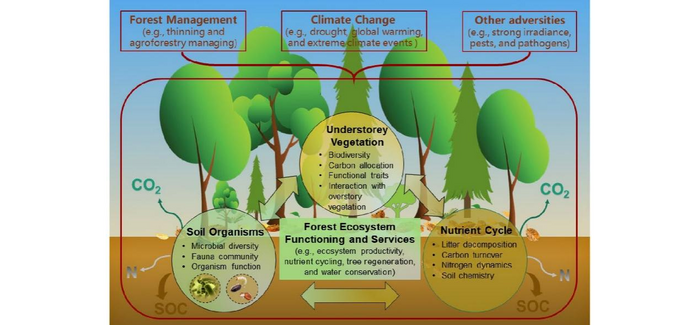The Xishuangbanna Tropical Botanical Garden of the Chinese Academy of Sciences (CAS), together with several other units in China and other countries, summarizes important research in the field of ecology related to the current status and future trends of forest undestory.
This review focuses on understory vegetation biodiversity, regeneration, biomass, nutrient content and storage, carbon and nitrogen relationships, functional traits, litter decomposition, and interactions with overstory trees. It also covers the ecological effects of understory vegetation on soil chemistry, soil microbial communities, and soil and water conservation. This work systematically summarizes the research status, shortcomings and future directions of these areas. Additionally, this review proposes that in the context of global climate change, future research should focus on the interaction between understory vegetation and canopy trees, as well as plant-soil interaction mechanisms driven by multiple climate or environmental factors and forest management practices at the regional scale, especially those involving lichen-moss layers and complex rhizosphere networks. These studies can be achieved through the application of advanced methods, including isotope labeling technology, high-throughput sequencing analysis, and organic matter grouping. In addition, the article recommends the development of more non-destructive technologies, such as 3D lidar scanning and hyperspectral scanning, combined with manual biodiversity surveys to monitor and characterize the dynamics of understory vegetation.
In conclusion, this article provides an overview of the current status, progress, and future directions of research on forest understory vegetation, including topics focused on forest biodiversity, ecosystem structure and function, and ecological services. We propose that a better understanding of understory vegetation can guide the regeneration, restoration and reconstruction of degraded forest ecosystems to maintain the multi-layered structure, spatial pattern and functions of the ecosystem. This improved understanding is critical to the effective management of understory vegetation in forest ecosystems, with potential benefits for both forest ecology and the economy. This review also provides scientific guidelines for professional technicians, managers, and policy makers to formulate better sustainable management practices for forests.
URL: https://www.eurekalert.org/news-releases/984512

Conceptual roles of understory vegetation in forest ecosystem functioning and services, and its response to management practice and climate change.

